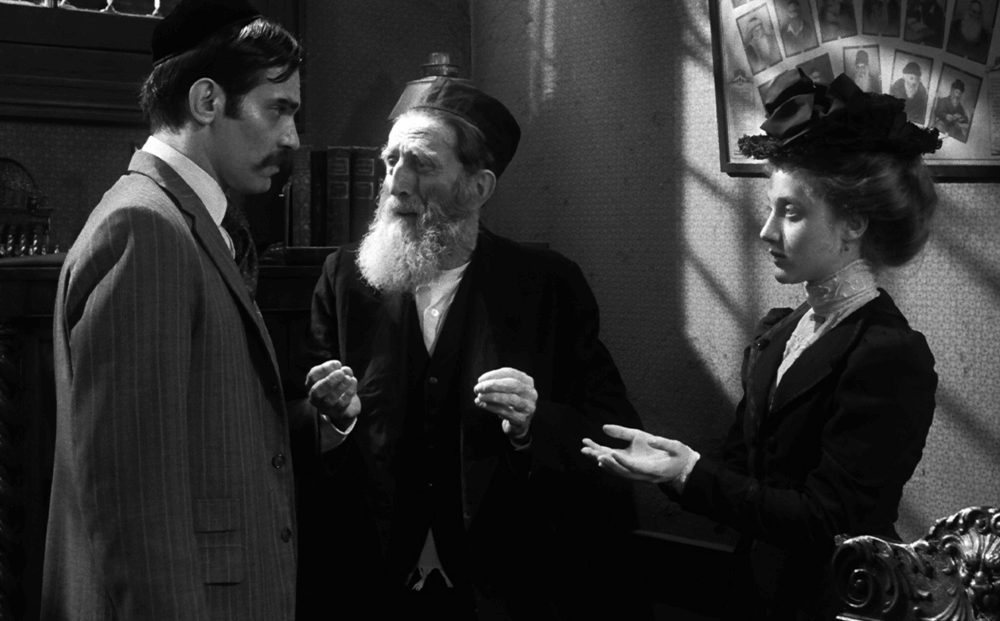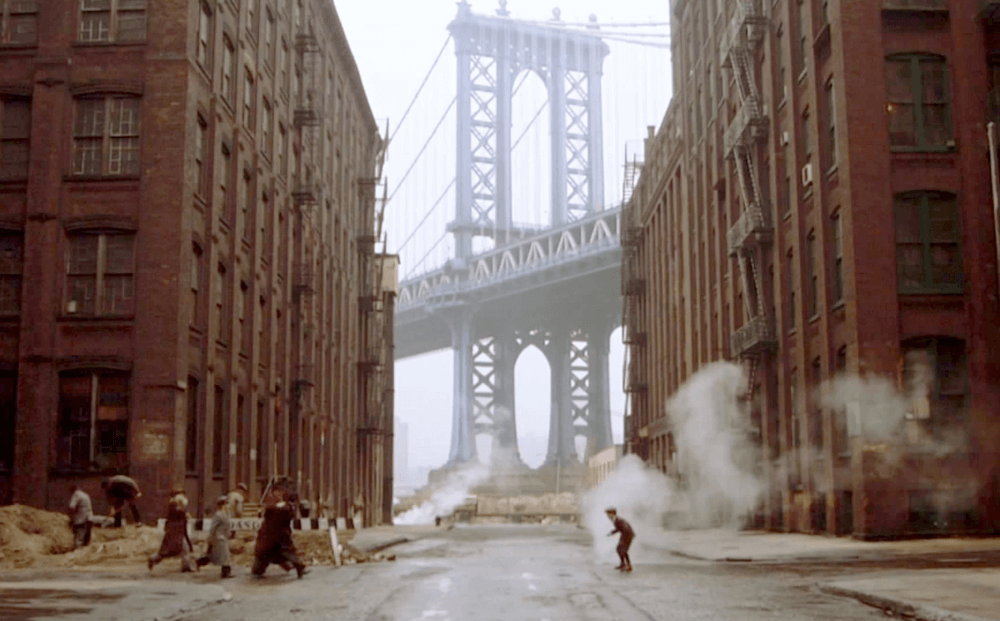In three films, a tale of three Jewish New Yorks
Film Forum is presenting ‘Uncle Moses,’ ‘Hester Street’ and ‘Once Upon a Time in America’ as part of its series on New York City

Graphic by Angelie Zaslavsky
When you hear the street names Delancey, Orchard or Hester, you might imagine the pushcarts and pickle barrels, the clotheslines hoisting linens, the great bazaar of cramped humanity. The imagery is easy to conjure, though the reality is now a mostly cinematic memory.
From May to June, Film Forum is offering an opportunity to tour the Lower East Side of the past in the series The City: Real and Imagined. Three of the films — one a Yiddish talkie, another a 1970s English-Yiddish period piece and the last a challenging American gangster epic by an Italian master — work both sides of the street, marrying the tangible and atmospheric with an illusory nostalgia. Taken together, they provide a panoramic picture of life as it was or may have been.
Uncle Moses (1932), a Yiddish talkie based on Sholem Asch’s novel, first syndicated in the Forverts in 1918, opens at the intersection of Orchard and Delancey — the only on-location shot in the film, and so, its most authentic.
Adapted from Maurice Schwartz’s stage play adaptation, and starring Schwartz as a hard-hearted shmatta factory owner, the film boasts a cast of Second Avenue veterans and was the most high-profile speaking picture of its day. In A Bridge of Light, J. Hoberman called it “one of the most confidently urban” Yiddish films for employing Yinglish in its parable of the ironically named Uncle Moses, who led the residents of his shtetl to America, only to have them slave away making garments in 14-hour shifts.
While the original story was written around the Great Immigration, Hoberman notes that there’s little in the film, released during the Depression, to date the material, making it an almost contemporary document. Yet because nearly the entire film was shot at the Metropolitan Studios in Fort Lee, New Jersey, Uncle Moses lacks many of the lived-in features modern viewers expect. The sets are sets, and feel like them, even as the tenement dwellers, crowding on the stairs to curry favor with Moses, are not far removed from the tenements themselves.
At the start of the film, we see Moses’ workers pressing and cutting and, in the final scene, we hear the whirr of new, mechanized sewing machines. Forty-three years later, Joan Micklin Silver recreated a sweatshop and showed women’s feet pumping the treadles.

Courtesy of Film Forum
The paradox of a period film like Hester Street is how, in crafting a memory of time and place, the mise en scene provides a more immersive experience; the camera lingers on mezuzahs and hanging sheets in an overpopulated attic room. Certainly, more advanced and mobile cameras, allowing for new angles and clearer pictures, helped this film feel less static than Uncle Moses, which in turn had no need to show its audience the conditions in which they lived.
Silver’s gorgeous, self-financed indie, based on Yekl, an 1896 novel by Forward founding editor Ab Cahan, is almost slavish in its attention to detail.
Pots and pans hang off every surface of a crammed kitchen, vendors walk the streets with onions tied to sticks and snacks nestled in cones made from Yiddish newspapers. Carol Kane and Steven Keats, as an incompatible married couple — he a self-styled Yankee, she a pious product of the shtetl — speak Yiddish, though they didn’t know the language when they were cast.
Not a memory piece in the strict sense, Hester Street nonetheless takes on a sort of Jewish communal memory later to be seized in Silver’s Crossing Delancey. Both films are about shifting tradition and romantic expectations.
Kane’s Gitl divorces her husband, and gets together with their Torah scholar boarder. Uncle Moses likewise releases his much younger wife, who married him under duress. Moses yields the business to unionization and the management of his Americanized nephew, and we last see him, approaching death, recalling a Yom Kippur tune from the old world he left behind.
One elegiac, and endlessly fascinating, reckoning with the Jewish past was not made by a Jew at all, but Spaghetti Western auteur Sergio Leone, who spent over a decade on his final film, 1984’s Once Upon a Time in America. Leone was so committed to telling the story he refused the chance to helm The Godfather.
It’s hard to imagine a Jew making a film like Once Upon a Time in the 1980s, for reasons of optics rather than accuracy. Based on the semi-autobiographical novel, The Hoods by Harry Grey (born Herschel Goldberg), it follows Jewish gangsters from their dirt-poor origins through to late life. These men rape, steal and murder. They won’t be up for any B’nai B’rith image awards, but are undeniably Jewish.
In a violent scene, one of the men threatens his lover with a string of English expletives and, also a “patsh in tukhes.” (Norman Mailer wrote an early draft that was, in Leone’s words, a “Mickey Mouse version.” Somehow a crew of Italian Catholics produced a finished script that feels credible if, in full, alive with questions for consultants like whether the shema would be said in Yiddish.)
Butchered to 138 minutes for its American release, Leone’s nearly four-hour director’s cut is expansive in a way few films of its kind are. The production built recreations of wide, Lower East Side blocks in three separate cities and peopled them with men in Shabbos coats and knish carts. A dairy restaurant is seen in three time periods — the 1920s, 1930s and 1960s — as it evolves to a deli housing a speakeasy and finally to a seedy bar and restaurant.

Through its changes in clientele and fare, the restaurant retains its tin ceiling and the Stars of David painted on the windows, a remnant of a kosher certification long since lapsed.
Melancholy and near-Proustian in its free-flowing flashbacks and pangs for a disappeared world, Leone’s patient, perhaps bloated fable explodes the insular stories of Hester Street and Uncle Moses. The central Jews — Robert De Niro as David “Noodles” Aaronson and James Woods as Maximilian Bercovicz — rub up against the Italian mob, Chinese immigrants running an opium den and an Irish labor organizer.
Leone’s sociology, casting a wider net with a more unsavory subject, brings to bear the same questions of belonging.
Forced to flee the city, Noodles makes his homecoming decades later to find Max has reinvented himself as the secretary of commerce named, in de-Judaized fashion, Christopher Bailey. Noodles is haunted by snatches of the Beatles’ “Yesterday” and Kate Smith’s “God Bless America” and by what he lost in his exile.
Once Upon a Time in America’s subject, like many great gangster and Jewish films, is the country’s fairy-tale quality, that allows the immutable — ethnicity, economics, love — to change but rarely, if ever, lets you forget where you came from.
The change, like the city where millions arrived expecting glittering streets and endless opportunity, is both real and imagined. We can trace our roots there, but we can never go back.
Film Forum is screening Uncle Moses May 21 and May 22. Hester Street is showing May 22 and 23. Once Upon a Time in America is screening May 28. More information and tickets can be found here.
















